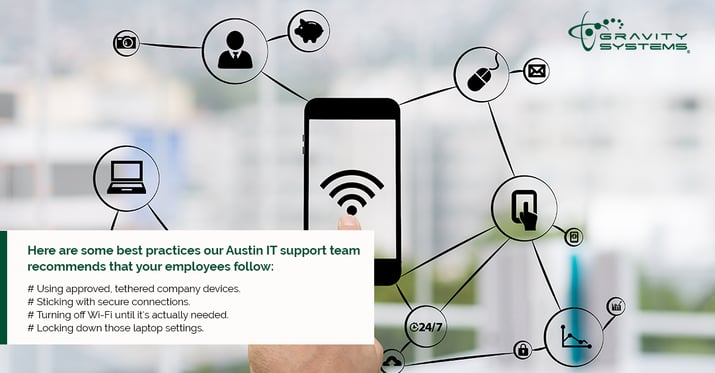
If your employees do much of their work on mobile devices, you'll want to make sure they understand how to play it smart when it comes to working via Wi-Fi. Here are some best practices our Austin IT support team recommends that your employees follow:
Using approved, tethered company devices. A “BYOD” (Bring Your Own Device) policy may be attractive to employees, but it also invites various security nightmares, from conducting company business over too many different devices (raising the risk for loss/theft) to using “jailbroken” phones that might allow malware to jump to or from a PC.
Sticking with secure connections. Instruct your employees to access only those domains that begin with “https” to make sure hackers can't eavesdrop on their online activities. We can make this easier for them by equipping their devices with automatic encryption programs such as VPN applications. You could even issue mobile hotspot routers on an as-needed basis to provide a regular source of wireless connectivity for their various devices.
Turning off Wi-Fi until it's actually needed. Advise employees to turn off the Wi-Fi on their mobile devices whenever there's no need for it. It's all too easy to leave this capability on all the time, which not only drains the device's battery but may also connect your device to the first unsecured Wi-Fi hotspot in the area.

Locking down those laptop settings. Your employees must lock down the settings on their laptop PCs that allow other users to connect to it if they plan on visiting public Wi-Fi zones. This includes turning off file sharing and designating all public hotspots as “Public” to disable the Windows Network Discovery feature. It also means keeping ad hoc networking mode disabled.
Questions about smart employee Wi-Fi practices? Feel free to ask Gravity Systems!
Related Post: Customized Machines vs. Off-the-Shelf Purchases

_NO_BCS_bigger_weird_green_clear.png?width=100&name=for-website_large(save-at-500-tall)_NO_BCS_bigger_weird_green_clear.png)


